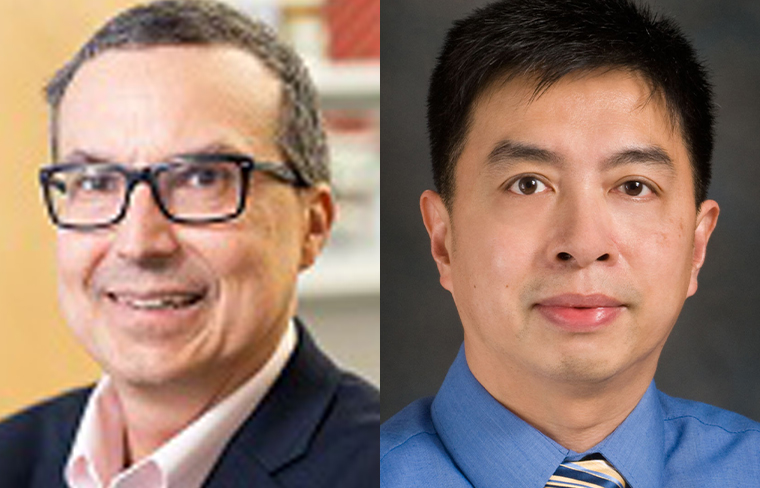
The latest news updates from the 2024 Symposium
-
Women who undergo mastectomy and reconstructive surgery may be at risk of becoming persistent drug users
Read More: Women who undergo mastectomy and reconstructive surgery may be at risk of becoming persistent drug usersWomen who receive mastectomy and reconstructive surgery as part of breast cancer treatment may face the risk of developing persistent use of opioids and sedative-hypnotic drugs.
-
Session evaluations, CME and Certificates of Attendance are available on the SABCS app
Read More: Session evaluations, CME and Certificates of Attendance are available on the SABCS appTo access the 2020 SABCS app sponsored by AstraZeneca, please search “San Antonio Breast Cancer Symposium” in the appropriate store (Google Play for Android, Apple for iOS) and download the app.
-
SABCS continues today with world-class science and a ‘can’t miss’ networking opportunity
Read More: SABCS continues today with world-class science and a ‘can’t miss’ networking opportunityDay three of SABCS 20 kicks off this morning with General Session 3, featuring abstract presentations covering some of the latest results in cancer research along with commentaries from expert discussants, followed by six Spotlight Sessions this afternoon.
-
Plenary Lecture: Dr. Mittendorf addresses ‘knowledge gap’ in local regional therapy after neoadjuvant treatment
Read More: Plenary Lecture: Dr. Mittendorf addresses ‘knowledge gap’ in local regional therapy after neoadjuvant treatmentIn one of two SABCS 20 Plenary Lectures, Elizabeth A. Mittendorf, MD, PhD, discussed local regional therapy considerations after neoadjuvant chemotherapy and summarized some of the key “knowns” and “unknowns” related to the topic.
-
Plenary Lecture: NCI Director updates SABCS attendees on progress during challenging times
Read More: Plenary Lecture: NCI Director updates SABCS attendees on progress during challenging timesLike most major medical conferences planned for 2020, SABCS kicked off in an all-virtual platform. Just as the meeting adapted to these challenging times, so too must cancer research, said Norman E. Sharpless, MD.
-
Basic Science Forum: New findings exploit tumor and immune ecosystem to enhance treatment
Read More: Basic Science Forum: New findings exploit tumor and immune ecosystem to enhance treatmentGrowing understanding of the melanoma microenvironment produced 11 targeted therapies for stage IV melanoma in the past decade. Breast cancer could be ripe for similar advances.
-
Clinical Science Forum: Bringing next generation sequencing into clinical practice
Read More: Clinical Science Forum: Bringing next generation sequencing into clinical practiceBreast cancer clinicians were among the first cancer specialists to use genetic information to guide treatment. Assessing ER/PR and HER2 positivity has become standard of care in breast cancer.
-
Translational Science Forum I: Speakers examine use of antibody-drug conjugates in BCa
Read More: Translational Science Forum I: Speakers examine use of antibody-drug conjugates in BCaThe antibody landscape is shifting. After years of using antibodies as therapeutic agents, they are being re-purposed as targeted vehicles to deliver highly toxic payloads to specific cell surface antigens.
-
Translational Science Forum II: Exploiting mechanisms of response to improve ICI outcomes
Read More: Translational Science Forum II: Exploiting mechanisms of response to improve ICI outcomesBetter understanding of how tumor cells respond to immune checkpoint inhibition (ICI) is revealing new approaches to predict and improve treatment response.
-
Updated monarchETrial data shows abemaciclib continues to benefit patients with high-risk, HR-positive, HER2-negative, early-stage breast cancer
Read More: Updated monarchETrial data shows abemaciclib continues to benefit patients with high-risk, HR-positive, HER2-negative, early-stage breast cancerExtended follow-up data from the phase III monarchE trial showed that adding the CDK inhibitor abemaciclib to standard adjuvant endocrine therapy continued to improve invasive disease-free survival among patients with high-risk, node-positive, early-stage, HR-positive, HER2-negative breast cancer.









